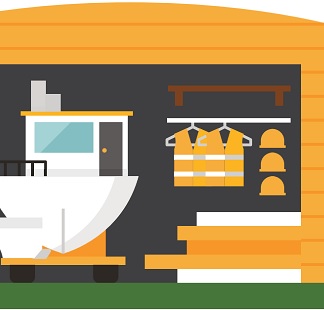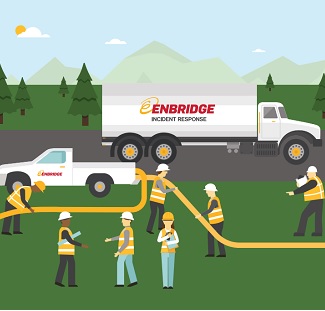Emergency management
At Enbridge1, safety is at the core of everything we do. Every day, we move the energy that Canadians and Americans count on: millions of barrels of oil, billions of cubic feet of natural gas and renewable energy. Life takes energy and it is our role to safely and reliably deliver the energy that helps fuel people’s lives.
We believe that all incidents can be prevented, and that spills and leaks are unacceptable. In the unlikely event that an incident occurs, Enbridge is ready to respond safely and effectively, in partnership with local first response agencies and regional and national authorities.
Our emergency management programs are built on the “Plan-Do-Check-Act” cycle to reinforce continuous improvement. This includes management reviews of our emergency management programs with senior business unit leaders. Enbridge’s emergency management programs are based on the following four pillars of emergency management:
|
Mitigation and Prevention |
Enbridge takes an all-hazards approach to emergency planning and risk analysis, which includes programs, plans and actions intended to prevent or reduce impacts. |
|
Preparedness |
Preparedness means the continuous cycle of planning, organizing, training, conducting exercises and taking corrective action in an effort to ensure effective coordination during an emergency response. |
|
Response |
Response is putting preparedness plans into action; it is the activation, mobilization, and coordination of all necessary resources and activities to manage a hazard, exposure, or threat’s immediate consequences in accordance with company emergency procedures. |
|
Recovery |
Recovery includes actions after an emergency which aim to restore the affected area back to its pre-incident or better condition. Recovery programs and activities should ensure that resources (people, teams, and equipment) are replaced/replenished/debriefed and that the response is reviewed as part of a continuous improvement process. |
Enbridge has emergency management programs embedded into each of its business units:
- Liquids Pipelines
- Gas Transmission and Midstream
- Gas Distribution and Storage
- Renewable Energy
Each emergency management program takes into account the specific risks associated with the operations of that respective business unit. The emergency management program is one of the protection programs that fits into the overall management system for each business unit.
Emergency management programs are much more than just emergency procedures manuals (also known as emergency response plans2), which are required by regulations. Enbridge is governed by provincial, state and federal regulations. We actively monitor changes to regulations and standards and update our programs regularly. The applicable regulations are identified in our management systems and each emergency response plan identifies the applicable regulations for the infrastructure that is covered. In Canada, the Canada Energy Regulator (CER) is the primary federal regulator. In the United States, the primary onshore federal regulator is the Pipeline and Hazardous Material Safety Administration (PHMSA). Numerous provincial and state regulators also have jurisdiction over Enbridge entities and infrastructure.
For CER-regulated assets, Enbridge is required to develop, implement and maintain emergency management programs that anticipate, prevent, manage and mitigate conditions during an emergency that could adversely affect the safety of workers or the public, the environment or property.3 In general, Enbridge emergency management programs accomplish this by:
- completing hazard assessments, including identifying high-consequence areas and defining planning zones.
- maintaining emergency response plans.
- maintaining an incident management system.
- liaising with agencies that may be involved during emergencies.
- communicating with persons who may be involved in an emergency.
- providing continuing education for emergency responders.
- having emergency response processes and capabilities in place.
- completing training and exercise programs.
- having appropriate equipment and contracts in place.
The full picture: Our emergency management programs
Find out more about various aspects of Enbridge's emergency management programs, including:
- Key public safety information;
- Our emergency response plans; and
- Our emergency management program summary.
Please note: The Emergency Management webpages on Enbridge.com are intended to meet the requirements of CER Order MO-002-2017, which requires companies that hold an authorization to construct and operate an oil or a gas pipeline or a gas processing plant to, among other things, publish and maintain information about its emergency management program.
Transmission pipeline mapping and GIS file access
For Emergency Officials in the United States, the U.S. Department of Transportation Pipeline and Hazardous Materials Administration (PHMSA) provides secure access to county-level maps through the National Pipeline Mapping System (NPMS) Pipeline Information Management Mapping Application (PIMMA).
The NPMS PIMMA provides a greater level of detail than what is available through the NPMS Public Viewer. Additionally, approved PIMMA users can request GIS data of all transmission pipelines within their jurisdiction. NPMS does not provide maps of local distribution or gathering lines.
To request PIMMA access, visit this link to apply. For general maps and inquiries into the NPMS system, the Public Viewer is available here.
1 The name "Enbridge" in the Emergency Management website section is considered to cover the following Enbridge companies that own or operate infrastructure regulated by the Canada Energy Regulator:
|
Liquids |
Gas |
|
Enbridge Pipelines Inc. |
Westcoast Energy Inc. |
|
Enbridge Bakken Pipeline Company Inc., on behalf of Enbridge Bakken Pipeline Limited Partnership |
Maritimes & Northeast Pipeline Management Ltd., on behalf of Maritimes & Northeast Pipeline Limited Partnership |
|
Enbridge Pipelines (NW) Inc. |
Enbridge Gas Inc. |
|
Enbridge Southern Lights GP Inc. on behalf of Enbridge Southern Lights LP |
Vector Pipeline Limited, on behalf of Vector Pipeline Limited Partnership |
|
Express Pipeline Ltd. |
St. Clair Pipelines Management Inc., on behalf of St. Clair Pipelines L.P. |
|
|
2193914 Canada Limited |
|
|
Niagara Gas Transmission Limited |
2 Note that the term “emergency response plan” is the term used throughout this document to encompass all of the common names used for documents outlining emergency response procedures, including: emergency procedures manual, emergency management manual, integrated contingency plan, emergency preparedness and response program.
3 The regulatory requirements for emergency management programs are outlined in sections 32-35 of the Canada Energy Regulator Onshore Pipeline Regulations (SOR/99-294).











